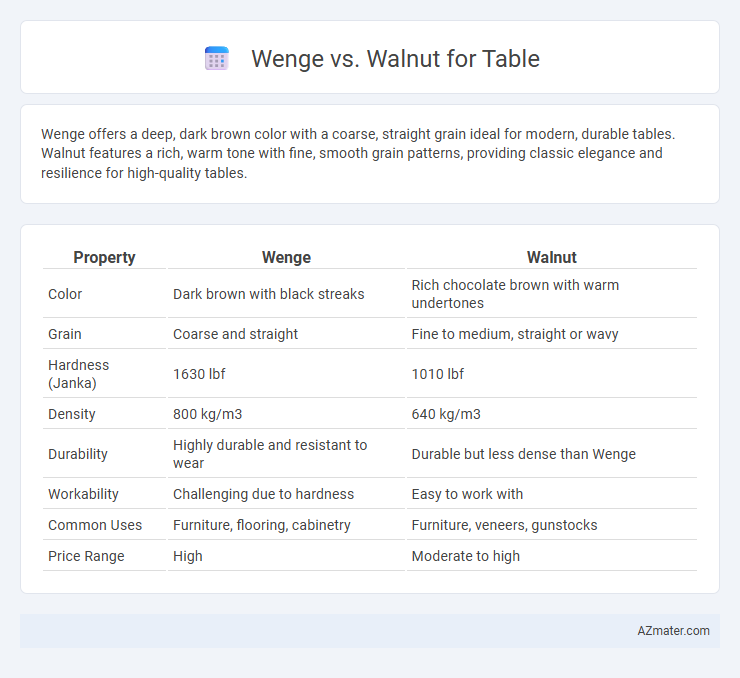Wenge offers a deep, dark brown color with a coarse, straight grain ideal for modern, durable tables. Walnut features a rich, warm tone with fine, smooth grain patterns, providing classic elegance and resilience for high-quality tables.
Table of Comparison
| Property | Wenge | Walnut |
|---|---|---|
| Color | Dark brown with black streaks | Rich chocolate brown with warm undertones |
| Grain | Coarse and straight | Fine to medium, straight or wavy |
| Hardness (Janka) | 1630 lbf | 1010 lbf |
| Density | 800 kg/m3 | 640 kg/m3 |
| Durability | Highly durable and resistant to wear | Durable but less dense than Wenge |
| Workability | Challenging due to hardness | Easy to work with |
| Common Uses | Furniture, flooring, cabinetry | Furniture, veneers, gunstocks |
| Price Range | High | Moderate to high |
Introduction to Wenge and Walnut Wood
Wenge and walnut are popular hardwood choices for tables, prized for their durability and rich appearance. Wenge wood, originating from Central Africa, features a deep, dark brown color with distinct black streaks, providing a bold, exotic look. Walnut, predominantly sourced from North America and Europe, offers a warm, chocolate-brown hue with a smooth grain pattern, valued for its classic elegance and versatility in furniture design.
Origin and Availability of Wenge and Walnut
Wenge wood originates primarily from the tropical forests of Central Africa, particularly in countries like the Democratic Republic of Congo and Cameroon, where its dense, dark grain is highly prized for furniture making. Walnut, especially Black Walnut, is native to North America, predominantly found in the United States and Canada, making it more readily available and sustainable with responsible forestry practices. Availability of Wenge is more limited and often costlier due to its exotic source and slower growth, while Walnut benefits from broader distribution and consistent supply in the lumber market.
Physical Appearance and Color Differences
Wenge wood showcases a deep, rich brown color with pronounced black streaks, offering a bold and exotic appearance that often features a straight, coarse grain pattern. Walnut, in contrast, presents a warm, medium to dark brown hue with subtle purplish undertones and a smoother, more uniform grain, providing a classic and refined look. The striking contrast in color between Wenge's darker, more dramatic tones and Walnut's softer, warmer shades significantly influences the visual impact and aesthetic suitability for tables.
Grain Patterns: Wenge vs Walnut
Wenge features a striking dark brown to black grain with a linear, straight pattern that often displays subtle, almost metallic streaks, creating a bold and dramatic look. Walnut exhibits a more varied grain pattern, ranging from straight to wavy or curly, with rich chocolate to lighter brown tones that add warmth and depth to any table design. The distinct grain textures of Wenge provide a modern, sleek appearance, while Walnut's intricate patterns enhance traditional and rustic aesthetics.
Durability and Hardness Comparison
Wenge wood offers superior durability with a Janka hardness rating of approximately 1630, making it highly resistant to dents and scratches, ideal for heavy-use tables. Walnut, with a lower Janka hardness of about 1010, provides moderate durability but is softer and more prone to surface wear under frequent use. For longevity and robust performance in table construction, Wenge outperforms Walnut in hardness and resistance to everyday damage.
Workability and Ease of Crafting
Wenge wood, known for its dense, coarse grain, offers moderate workability but requires sharp tools due to its hardness and tendency to dull blades quickly, making crafting more labor-intensive compared to walnut. Walnut is prized for its fine, straight grain and smoother texture, allowing for easier cutting, shaping, and sanding, which enhances precision in table-making. Craftsmen often prefer walnut for intricate details and refined finishes due to its superior ease of crafting and less abrasive nature.
Maintenance and Longevity
Wenge wood offers exceptional durability and resistance to wear, requiring minimal maintenance beyond regular dusting and occasional oiling to preserve its deep, dark finish. Walnut, while slightly softer, demands more frequent care to protect its natural grain and prevent scratches, often benefiting from periodic waxing or conditioning treatments. Both woods provide excellent longevity when properly maintained, but Wenge's dense hardness makes it more resilient for high-traffic table surfaces.
Cost and Market Prices
Wenge wood typically commands higher market prices due to its rarity and rich, dark brown to almost black appearance, making it a premium choice for tables. Walnut, while still considered a high-quality hardwood, is more widely available and generally costs less than wenge, offering excellent durability and a warm, rich grain at a more accessible price point. Cost differences between wenge and walnut tables can vary significantly based on regional availability, with wenge often priced 20-40% higher in most markets.
Environmental Impact and Sustainability
Wenge wood, sourced primarily from Central Africa, often faces sustainability challenges due to overharvesting and limited regeneration rates, leading to concerns about deforestation and habitat loss. Walnut, especially American black walnut, is generally harvested from managed forests with more established sustainable practices, resulting in a lower environmental footprint. Choosing walnut for tables typically supports better forest management and reduced ecological harm compared to wenge.
Which Wood is Best for Your Table?
Wenge offers a rich, dark brown color with striking grain patterns, making it ideal for statement tables that require durability and resistance to wear. Walnut provides a warm, medium-brown tone with smooth grain and excellent workability, perfect for elegant, timeless tables with a refined finish. Choosing between Wenge and Walnut depends on your preference for bold, contemporary aesthetics versus classic, versatile design combined with hardness and stability.

Infographic: Wenge vs Walnut for Table
 azmater.com
azmater.com